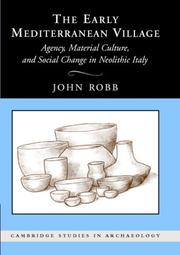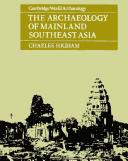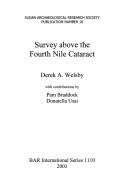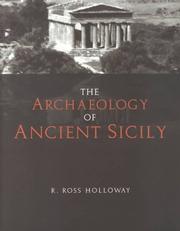| Listing 1 - 10 of 320 | << page >> |
Sort by
|
Book
ISBN: 0140463518 Year: 1982 Publisher: Harmondsworth Penguin books
Abstract | Keywords | Export | Availability | Bookmark
 Loading...
Loading...Choose an application
- Reference Manager
- EndNote
- RefWorks (Direct export to RefWorks)
England --- Prehistoric antiquities --- Antiquities. --- Gazetteers. --- Prehistoric antiquities.
Book
ISBN: 2200214936 9782200214937 Year: 1994 Publisher: Paris: Armand Colin,
Abstract | Keywords | Export | Availability | Bookmark
 Loading...
Loading...Choose an application
- Reference Manager
- EndNote
- RefWorks (Direct export to RefWorks)
Antiquities, Prehistoric --- Excavations (Archaeology) --- Iraq --- Antiquities --- -Antiquities, Prehistoric --- -Prehistoric antiquities --- Prehistoric archaeology --- Prehistory --- Prehistoric peoples --- -Antiquities --- -Iraq --- Prehistoric antiquities --- Antiquities. --- Antiquities, Prehistoric - Iraq --- Excavations (Archaeology) - Iraq --- Iraq - Antiquities

ISBN: 9780521842419 0521842417 9780511499647 9781107661103 9780511342356 0511342357 0511499647 1107661102 110717516X 128108493X 9786611084936 1139130927 0511341822 0511341288 0511340702 Year: 2007 Volume: *3 Publisher: Cambridge ; New York : Cambridge University Press,
Abstract | Keywords | Export | Availability | Bookmark
 Loading...
Loading...Choose an application
- Reference Manager
- EndNote
- RefWorks (Direct export to RefWorks)
What was daily life like in Italy between 6000 and 3500 BC? In this book, first published in 2007, John Robb brings together the archaeological evidence on a wide range of aspects of life in Neolithic Italy and surrounding regions (Sicily and Malta). Exploring how the routines of daily life structured social relations and human experience during this period, Robb provides a detailed analysis of how people built houses, buried their dead, made and shared a distinctive cuisine, and made the pots and stone tools that archaeologists find. He also addresses questions of regional variation and long-term change, showing how the sweeping changes at the end of the Neolithic were rooted in and transformed the daily practices of earlier periods. Robb links the agency of daily life and the reproduction of social relations with long-term patterns in European prehistory.
Antiquities, Prehistoric --- Neolithic period --- Prehistoric antiquities --- Prehistoric archaeology --- Prehistory --- Prehistoric peoples --- Italy --- Antiquities. --- Social Sciences --- Archeology

ISBN: 0521275253 Year: 1991 Publisher: Cambridge Cambridge university press
Abstract | Keywords | Export | Availability | Bookmark
 Loading...
Loading...Choose an application
- Reference Manager
- EndNote
- RefWorks (Direct export to RefWorks)
Antiquities, Prehistoric --- Prehistoric antiquities --- Prehistoric archaeology --- Prehistory --- Prehistoric peoples --- Southeast Asia --- Antiquities.

ISBN: 1841714887 Year: 2003 Publisher: Oxford : Archaeopress,
Abstract | Keywords | Export | Availability | Bookmark
 Loading...
Loading...Choose an application
- Reference Manager
- EndNote
- RefWorks (Direct export to RefWorks)
Antiquities, Prehistoric --- Excavations (Archaeology) --- Prehistoric antiquities --- Prehistoric archaeology --- Prehistory --- Prehistoric peoples --- Sudan --- Antiquities.
Book
ISBN: 392755216X Year: 1993 Publisher: Heidelberg : Heidelberger Orientverlag,
Abstract | Keywords | Export | Availability | Bookmark
 Loading...
Loading...Choose an application
- Reference Manager
- EndNote
- RefWorks (Direct export to RefWorks)
Antiquities, Prehistoric --- Prehistoric antiquities --- Prehistoric archaeology --- Prehistory --- Prehistoric peoples --- Egypt --- Antiquities.
Book
ISBN: 9780199556427 0199556423 Year: 2013 Publisher: London Oxford University Press
Abstract | Keywords | Export | Availability | Bookmark
 Loading...
Loading...Choose an application
- Reference Manager
- EndNote
- RefWorks (Direct export to RefWorks)
"Humans occupy a material environment that is constantly changing. Yet in the twentieth century archaeologists studying British prehistory have overlooked this fact in their search for past systems of order and pattern. Artefacts and monuments have been treated as inert materials which were the outcomes of social ideas and processes. As a result materials were variously characterized as stable entities such as artefact categories, styles, or symbols in an attempt to comprehend them. In this book Jones argues that, on the contrary, materials are vital, mutable, and creative, and archaeologists need to attend to the changing character of materials if they are to understand how past people and materials intersected to produce prehistoric societies. Rather than considering materials and societies as given, he argues that we need to understand how these entities are performed. Jones analyses various aspects of materials, including their scale, colour, fragmentation, and assembly, in a wide-ranging discussion which covers the pottery, metalwork, rock art, passage tombs, barrows, causewayed enclosures, and settlements of Neolithic and Early Bronze Age Britain and Ireland."--Jacket.
Antiquities, Prehistoric --- Material culture --- History --- Culture --- Folklore --- Technology --- Prehistoric antiquities --- Prehistoric archaeology --- Prehistory --- Prehistoric peoples

ISBN: 1134557736 1280045639 0585453284 9786610045631 0203469623 9780585453286 0415237912 1134557728 9780415237918 Year: 2000 Publisher: London : Routledge,
Abstract | Keywords | Export | Availability | Bookmark
 Loading...
Loading...Choose an application
- Reference Manager
- EndNote
- RefWorks (Direct export to RefWorks)
The standard work on the archaeology of ancient Sicily, Holloway's now updated study provides the only comprehensive introduction to the wealth of artefacts and monuments discovered on the island.
Antiquities, Prehistoric --- Excavations (Archaeology) --- Prehistoric antiquities --- Prehistoric archaeology --- Prehistory --- Prehistoric peoples --- Sicily (Italy) --- Antiquities.
Book
ISBN: 9088901767 9789088901768 9789088900808 9088900809 Year: 2011 Publisher: Leiden : Sidestone Press,
Abstract | Keywords | Export | Availability | Bookmark
 Loading...
Loading...Choose an application
- Reference Manager
- EndNote
- RefWorks (Direct export to RefWorks)
DUTCH DESCRIPTION: In het werk en onderzoek van Eric Lohof staat de Nederlandse prehistorie centraal, en die van het Neolithicum en de Bronstijd in het bijzonder. Ter ere van Eric's pensioen in 2011 is rondom dit onderwerp een feestbundel samengesteld met bijdragen van vrienden, collega's en vakgenoten. In deze bijzondere samenwerking tussen archeologen uit de academische wereld en de private sector is een dwarsdoorsnede geschetst van wat de Nederlandse prehistorische archeologie te bieden heeft. Het richt zich op de nieuwe technische ontwikkelingen in het steentijdonderzoek en op de mogelijkh
Tombs. --- Antiquities, Prehistoric. --- Prehistoric antiquities --- Prehistoric archaeology --- Prehistory --- Prehistoric peoples --- Archeology --- Netherlands
Book
ISBN: 0511705913 1108017460 Year: 2011 Publisher: Cambridge : Cambridge University Press,
Abstract | Keywords | Export | Availability | Bookmark
 Loading...
Loading...Choose an application
- Reference Manager
- EndNote
- RefWorks (Direct export to RefWorks)
Amateur geologist and archaeologist, Boucher de Perthes (1788-1868) was the first to establish the existence of man in Europe in the Pleistocene period. Although his three-volume work resulted from over ten years of excavations in the gravel pits of the Somme Valley, Boucher de Perthes' assertions were doubted by contemporaries. His conclusion was based on the simultaneous discovery of flint tools and human remains. These doubts appeared justified when a human jaw uncovered during one of his excavations turned out to be a hoax. De Perthes' findings later received support from the British Royal Society, sparking an explosion of scientific research on evolution. De Perthes was elected an officer of the Legion d'Honneur, and served as President of the Société d'Emulation d'Abbeville (Competitiveness Society) for seventeen years. Volume 1 reports the findings of excavations from 1837 to 1846.
Antiquities, Prehistoric. --- France --- Antiquities. --- Prehistoric antiquities --- Prehistoric archaeology --- Prehistory --- Prehistoric peoples
| Listing 1 - 10 of 320 | << page >> |
Sort by
|

 Search
Search Feedback
Feedback About UniCat
About UniCat  Help
Help News
News